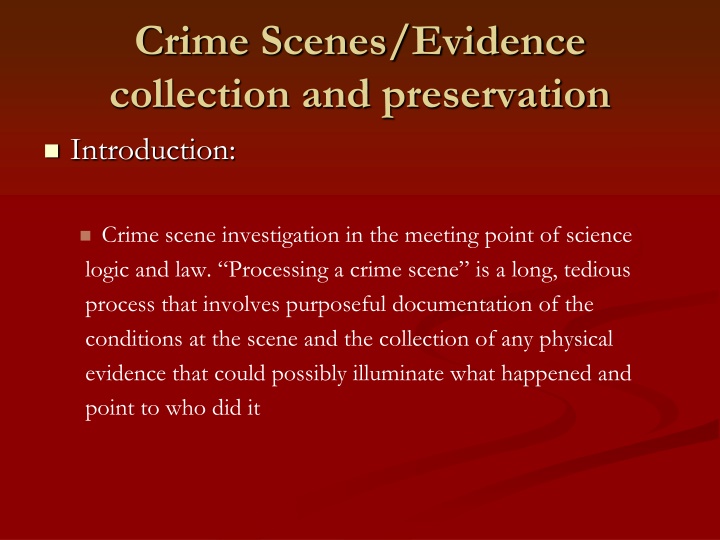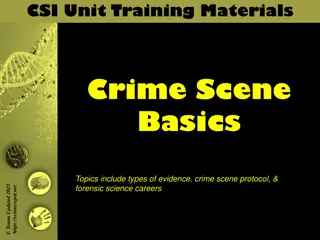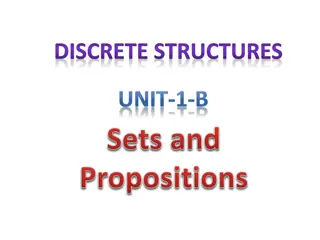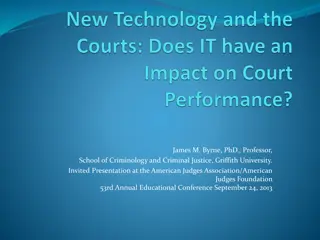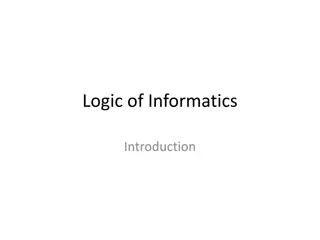Crime Scenes and Evidence Collection: The Intersection of Science, Logic, and Law
Crime scene investigation is a meticulous process that involves documenting the scene conditions and collecting physical evidence to unravel the truth behind a crime. Understanding what constitutes a crime scene, the importance of evidence, conducting initial surveys, taking precautions, and conducting thorough searches are crucial aspects in this investigative process. Additionally, the significance of photographing the crime scene and the evidence collected cannot be understated, as it provides a permanent visual record that aids in the investigation and legal proceedings.
Uploaded on Sep 24, 2024 | 0 Views
Download Presentation

Please find below an Image/Link to download the presentation.
The content on the website is provided AS IS for your information and personal use only. It may not be sold, licensed, or shared on other websites without obtaining consent from the author.If you encounter any issues during the download, it is possible that the publisher has removed the file from their server.
You are allowed to download the files provided on this website for personal or commercial use, subject to the condition that they are used lawfully. All files are the property of their respective owners.
The content on the website is provided AS IS for your information and personal use only. It may not be sold, licensed, or shared on other websites without obtaining consent from the author.
E N D
Presentation Transcript
Crime Scenes/Evidence collection and preservation Introduction: Crime scene investigation in the meeting point of science logic and law. Processing a crime scene is a long, tedious process that involves purposeful documentation of the conditions at the scene and the collection of any physical evidence that could possibly illuminate what happened and point to who did it
Investigations of Crime Scenes What is a Crime Scene? -A crime scene is a location where a crime took place. What is Evidence? -Evidence, broadly construed, is anything presented ln support of an assertion.
Investigations of Crime Scenes Conducting the Initial Survey of a Crime Scene. -Ask yourself these questions 1. Is the scene safe to enter? 2. Does the scene contain a person who may need medical assistance? 3. Do any hazards exist to emergency responders? 4. Is a search warrant needed?
Investigations of Crime Scenes Conducting the Initial Survey of a Crime Scene. - Precautions at the Scene. 1. Approach the scene safely. -First Priority 2. Be aware of discarded items that may be evidence. -Weapons, hazardous materials, 3. Always secure and protect entry to the scene. -atmospheric and or Dangerous persons 4. Are you going to need assistance. -Notify Supervisory Personnel
Investigations of Crime Scenes Conducting a Crime Scene Search. 1. Prepare a narrative description. 2. Make notes-for your written report later. 3. What are you observing. 4. Contacts-people interviewed/arrested. 5. Evidence found and recovered-Tagged(time and location), packaged, photographed, all items listed on a property page.
Photographs allow a visual permanent record of the crime scene and items of evidence collected .
Taking crime scene photographs: - Photographs should be taken as soon as possible. - Three Positions or views: -Overall scene. -Mid-range photographs. -Close up.
Photographs start to finish: 1. Photograph entire area before it is entered. 2. Photograph victims, crowds, and vehicles. 3. Photograph entire scene with Overall, Medium, and close-up coverage, Using measurement scale when appropriate.
Photographs start to finish: 4. Photograph major evidence items before they are moved. 5. Photograph all latent fingerprints and other impression evidence before lifting and casting are accomplished. 6. Prepare photographic log and photographic sketch.
FIELD NOTES 1. 2. 3. 4. What is a Field Note? - to remember and record the behaviors, activities, events Why take notes? - basis to produce meaning and an understanding What should you be writing down? -observation, statements What are some of the department policies for notes. - AR 458, NRS 209.131
Survey/Search Methods 1. 2. Purpose of crime scene investigation? A. To help establish what happened B. To Identify the responsible person. Method. A. Carefully documenting of conditions at the scene. B. Recognizing all relevant physical evidence.
Precautions at the scene -A deliberate, methodical, disciplined approach to collection and preservation of evidence is essential. One exception Evidence Integrity is at Risk.
Precautions at the scene Types of Equipment Include: -Tyvek white paper body suit. -Paper mask which covers nose and mouth. -Eye Protection. -Latex or Nitrile gloves. -Sleeve protectors. -Shoe covers. -Hair net.
Evidence Collection and Removal Types of Evidence Include: -Fingerprints -Footwear impressions -Hair -Fibers -Biological fluids -materials for DNA analysis -Anything used to commit the crime
Preservation of Evidence From the Crime Scene . To the courtroom.
Computer Crimes Evidence Seizure of Devices Containing Electronic Evidence: Cellular Telephones Computers Media Players such as Ipods or (Purchased MP3 Player from store are approved.) Corrections staff seizing electronic evidence should handle evidence as little as possible and under no circumstances should staff turn these devices on or attempt to extract information form them.
Chain-of-Custody Proper evidence packaging includes: - Appropriate packaging and labeling of all items, each item properly sealed, marked, correct and consistent information recorded on labels and procedural documentation.
Chain-of-Custody Make sure your information is accurate Information must be consistent on all paperwork; who, what, when, where, etc.. Do not use generic terms when describing contraband (i.e. shank, etc.) Be as specific as possible to describe item Don t make assumptions, report facts
Chain-of-Custody 1. is collected. The chain of custody begins when the item 2. one person to another, the person receiving it shall sign for it before taking possession. Any time contraband is turned over from
Chain-of-Custody Biological Fluids and Stains: -Proper handling is essential A. Use disposable gloves. B. Any item confiscated that has blood, semen, urine, etc. should be handled with extreme care. Most items should be packaged in paper bags and all should be marked Biohazard.
Chain-of-Custody Biological Fluids and Stains: -Rape Evidence
Chain-of-Custody Biological Fluids and Stains: -Stains on Garments or Fabrics A. Wet stained fabrics must air dry. B. Package multiple items separately C. DO NOT USE PLASTIC BAGS
Chain-of-Custody Biological Fluids and Stains: -Stains on Garments or Fabrics D. Avoid unnecessary handling of garments with blood or seminal stains. E. Initial and dated in an area away form the stain. F. Label and seal all items
Chain-of-Custody Biological Fluids and Stains: -Stains on Surfaces 1. Items to be checked for blood should not be dusted for Prints. 2. Whenever possible, submit the bloodstained item itself for analysis. If this is impractical, detach or cut out the part with the stain for submission. Carefully package to avoid contamination or loss. Do not put any tape directly on the stain.
Chain-of-Custody Biological Fluids and Stains: -Stains on Surfaces 3. Bloodstains can be swabbed off items which cannot be submitted. Swab the blood onto a cotton- tipped applicator that has been slightly dampened with distilled water, in a manner which concentrates the sample. Swab and unstained area of the same surface in the same manner for a control. Air dry and package the stain and control swabs separately in paper.
Chain-of-Custody Biological Fluids and Stains: -Stains on Surfaces 4.Concentrated stains on walls, floors, etc. (i.e., items that cannot be cut out and submitted), can be scraped off into a piece of paper which is thecarefully folded and then placed in a pillbox or other suitable container. This container and the paper should be initialed and dated or otherwise identified.
Chain-of-Custody Biological Fluids and Stains: -Stains on Surfaces 5. If the stain is moist, let it air dry first, or swab it onto a cotton tipped applicator then air dry.
Chain-of-Custody Firearms & Ammunition 1. Always unload the firearm before submitting it for evidence.
Chain-of-Custody Hairs and fibers A. Hair evidence is generally small B. Detecting hair 1. visual search, alternate light sources, magnification search. 2. picking, scraping, combing, or vacuuming.
Chain-of-Custody Hairs and fibers C. If the location of a foreign hair is important, they should be collected and packaged separately. D. Wrap clothing or evidence items separately.
Chain-of-Custody Tool marks and tools: - impression, cut, gouge, or abrasion caused by a tool coming into contact with another object. - may be photographed , if easily removed it may be taken as evidence. - hard to accurately reproduce the tool mark for future comparison.
Overview Finishing processing: Final survey is a review of all aspects of the search Discuss he search with all personnel Photograph the scene showing the final condition Ensure all evidence is secured Ensure all equipment is retrieved Ensure hiding places or difficult access areas have not been overlooked
Overview Release: Release the crime scene after the final survey Crime scene release documentation should include the time and date of release, to whom released, and by whom released Ensure that the evidence is collected according to legal requirements, documented, policy and marked for identification Consider the need for specialists such as a blood-pattern analyst or a medical examiner to observe the scene before it is released
Overview Release: Once the scene has been released reentry may require a warrant The scene should be released only when all personnel are satisfied that the scene was searched correctly and completely Only the person in charge should release the scene
Chain of Custody for Evidence The Chain of Custody requires three Types of Testimony: 1. Testimony that a piece of evidence is what it purports to be 2. Testimony of continuous possession by each individual 3. Testimony by each person who had possession that the particular piece of evidence remained in substantially the same condition from possession of one person to another
Packaging All packages should contain the following information: Description of the item use generic terms, not jail lingo like shank Where it was found Person s name and number (if applicable) Date and time found Name of staff seizing the item 1. 2. 3. 4. 5. PAPERWORK ATTACHED TO PACKAGING IS NOT ENOUGH!!
